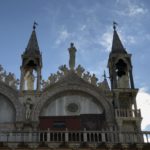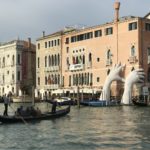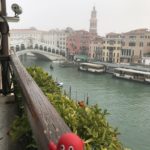Venice – 27,535 Fit Bit steps
We first visited Venice at Easter in 2007 when we took the train from Geneva. It was no less magical the second time, now shrouded in mist and fog. To walk across the bridge over the Grand Canal is to enter another world of waterways, gondolas, narrow alleys, squares and historic buildings. We were happy to avoid the still very busy tourist spots in favour of just wandering, window shopping, Christmas shopping, photographing and eating. While we were chatting with the proprietor of Signor Blum, a handcrafted wooden toy store, costumed children came in banging pots and pans and asking for candy in celebration of the Festival of St. Martin.
We visited the Basilica dei Santi Giovanni e Paolo, with its original Murano stained glass windows, the Chiesa di Santa Maria dei Miracoli and the Ca’ Pesaro Galleria Internazionale d’Arte. In addition to its impressive international collection, the gallery has a rich collection of 20th-century canvasses and sculptures by Italian artists, including Boccioni, Martini, Wildt, Donghi, Morandi, De Chirico, and others.
In the Scuola Grande di San Rocco, we were moved by paintings depicting the Black Plague of the 14thC. Between 1350 and 1700, over 100 waves of Bubonic plague swept Europe spread westward by rats and their fleas hitchhiking on ships along the Venetian and Genovese trade routes. Historians estimate that about 75 million people died, one third of them in Europe. “Quarantine” comes from a Venetian word and indeed, in 1348, the City appointed public health guardians to try to prevent plague coming into the City. Although not wholly successful, it was a pioneering attempt at prevention. Outbreaks in Venice in the 16th and 17th centuries claimed the lives of 30% of the city’s population, leading to its ultimate demise as a world sea power. (Paul notes that the disease is still a threat in some endemic areas – see current outbreak in Madagascar). Celebrating Carnival each year, Venetians still remember their historic past. They dress up in masks and costumes that represent the Bubonic Plague, the creation of a quarantine island, a female vampire in Venice, and the impact on their history.
The threat to Venice now is not rapid, but slow and insidious, as rising sea levels caused by climate change pose new challenges for the survival of this great city, a concern highlighted by Support, a sculpture installation by Lorenzo Quinn for the Venice Biennale 2017. The artist writes that, “Venice is a floating art city that has inspired cultures for centuries, but to continue to do so it needs the support of our generation and future ones, because it is threatened by climate change and time decay.”
Venice is built over 100 low-lying islands in a salt water lagoon which is sheltered from the Adriatic Sea by the Lido- a sandbank- and other small strips of land. It is unlikely that this will survive the ravages of climate change and rising sea levels. Even now, we saw posters showing the few alleys and routes that would be open with the high tides likely to occur this winter, not an unusual occurrence, but likely to become more frequent. We kept looking at the proximity of doors fronting on to the water and how close houses are to being inundated. The controversial 5.4B Euro MOSE flood barrier project which will insert gates in the three inlets through which water enters and leaves the lagoon, will mitigate the effects of the high tides, but are only designed to be effective for a rise in sea levels up to 80cm, so may not save Venice in the long term.









